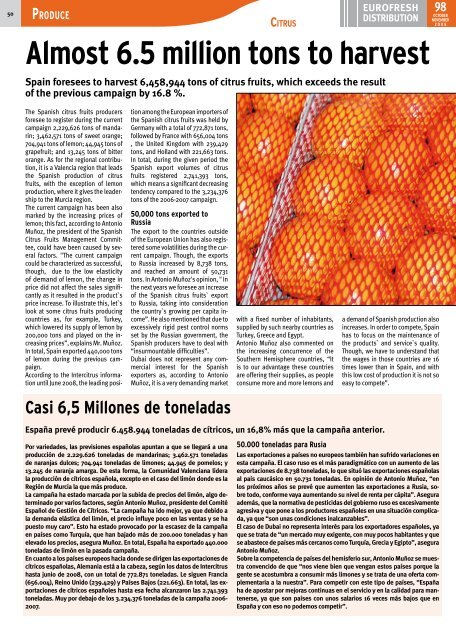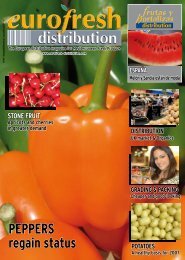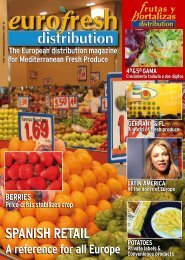produce - Eurofresh Distribution
produce - Eurofresh Distribution
produce - Eurofresh Distribution
Create successful ePaper yourself
Turn your PDF publications into a flip-book with our unique Google optimized e-Paper software.
0<br />
Produce<br />
citruS<br />
EUROFRESH<br />
DISTRIBUTION<br />
Almost 6.5 million tons to harvest<br />
Spain foresees to harvest , 8,9 tons of citrus fruits, which exceeds the result<br />
of the previous campaign by 1 .8 %.<br />
The Spanish citrus fruits <strong>produce</strong>rs<br />
foresee to register during the current<br />
campaign 2,229,626 tons of mandarin;<br />
3,462,571 tons of sweet orange;<br />
704,941 tons of lemon; 44,945 tons of<br />
grapefruit; and 13,245 tons of bitter<br />
orange. As for the regional contribution,<br />
it is a Valencia region that leads<br />
the Spanish production of citrus<br />
fruits, with the exception of lemon<br />
production, where it gives the leadership<br />
to the Murcia region.<br />
The current campaign has been also<br />
marked by the increasing prices of<br />
lemon; this fact, according to Antonio<br />
Muñoz, the president of the Spanish<br />
Citrus Fruits Management Committee,<br />
could have been caused by several<br />
factors. "The current campaign<br />
could be characterized as successful,<br />
though, due to the low elasticity<br />
of demand of lemon, the change in<br />
price did not affect the sales significantly<br />
as it resulted in the product`s<br />
price increase. To illustrate this, let`s<br />
look at some citrus fruits producing<br />
countries as, for example, Turkey,<br />
which lowered its supply of lemon by<br />
200,000 tons and played on the increasing<br />
prices”, explains Mr. Muñoz.<br />
In total, Spain exported 440,000 tons<br />
of lemon during the previous campaign.<br />
According to the Intercitrus information<br />
until June 2008, the leading posi-<br />
tion among the European importers of<br />
the Spanish citrus fruits was held by<br />
Germany with a total of 772,871 tons,<br />
followed by France with 656,004 tons<br />
, the United Kingdom with 239,429<br />
tons, and Holland with 221,663 tons.<br />
In total, during the given period the<br />
Spanish export volumes of citrus<br />
fruits registered 2,741,393 tons,<br />
which means a significant decreasing<br />
tendency compared to the 3,234,376<br />
tons of the 2006-2007 campaign.<br />
50,000 tons exported to<br />
Russia<br />
The export to the countries outside<br />
of the European Union has also registered<br />
some volatilities during the current<br />
campaign. Though, the exports<br />
to Russia increased by 8,738 tons,<br />
and reached an amount of 50,731<br />
tons. In Antonio Muñoz's opinion, " In<br />
the next years we foresee an increase<br />
of the Spanish citrus fruits` export<br />
to Russia, taking into consideration<br />
the country`s growing per capita income”.<br />
He also mentioned that due to<br />
excessively rigid pest control norms<br />
set by the Russian government, the<br />
Spanish <strong>produce</strong>rs have to deal with<br />
“insurmountable difficulties”.<br />
Dubai does not represent any commercial<br />
interest for the Spanish<br />
exporters as, according to Antonio<br />
Muñoz, it is a very demanding market<br />
Casi 6,5 Millones de toneladas<br />
with a fixed number of inhabitants,<br />
supplied by such nearby countries as<br />
Turkey, Greece and Egypt.<br />
Antonio Muñoz also commented on<br />
the increasing concurrence of the<br />
Southern Hemisphere countries, “It<br />
is to our advantage these countries<br />
are offering their supplies, as people<br />
consume more and more lemons and<br />
España prevé producir . 8.9 toneladas de cítricos, un 1 ,8% más que la campaña anterior.<br />
Por variedades, las previsiones españolas apuntan a que se llegará a una<br />
producción de 2.229. 2 toneladas de mandarinas; . 2. 1 toneladas<br />
de naranjas dulces; 0 .9 1 toneladas de limones; .9 de pomelos; y<br />
1 .2 de naranja amarga. De esta forma, la Comunidad Valenciana lidera<br />
la producción de cítricos española, excepto en el caso del limón donde es la<br />
Región de Murcia la que más <strong>produce</strong>.<br />
La campaña ha estado marcada por la subida de precios del limón, algo determinado<br />
por varios factores, según Antonio Muñoz, presidente del Comité<br />
Español de Gestión de Cítricos. “La campaña ha ido mejor, ya que debido a<br />
la demanda elástica del limón, el precio influye poco en las ventas y se ha<br />
puesto muy caro”. Esto ha estado provocado por la escasez de la campaña<br />
en países como Turquía, que han bajado más de 200.000 toneladas y han<br />
elevado los precios, asegura Muñoz. En total, España ha exportado 0.000<br />
toneladas de limón en la pasada campaña.<br />
En cuanto a los países europeos hacia donde se dirigen las exportaciones de<br />
cítricos españolas, Alemania está a la cabeza, según los datos de Intercitrus<br />
hasta junio de 2008, con un total de 2.8 1 toneladas. Le siguen Francia<br />
( .00 ), Reino Unido (2 9. 29) y Países Bajos (221. ). En total, las exportaciones<br />
de cítricos españoles hasta esa fecha alcanzaron las 2. 1. 9<br />
toneladas. Muy por debajo de los .2 . toneladas de la campaña 200 -<br />
200 .<br />
98<br />
OCTOBER<br />
NOVEMBER<br />
2 0 0 8<br />
a demand of Spanish production also<br />
increases. In order to compete, Spain<br />
has to focus on the maintenance of<br />
the products` and service`s quality.<br />
Though, we have to understand that<br />
the wages in those countries are 16<br />
times lower than in Spain, and with<br />
this low cost of production it is not so<br />
easy to compete”.<br />
50.000 toneladas para Rusia<br />
Las exportaciones a países no europeos también han sufrido variaciones en<br />
esta campaña. El caso ruso es el más paradigmático con un aumento de las<br />
exportaciones de 8. 8 toneladas, lo que situó las exportaciones españolas<br />
al país caucásico en 0. 1 toneladas. En opinión de Antonio Muñoz, “en<br />
los próximos años se prevé que aumenten las exportaciones a Rusia, sobre<br />
todo, conforme vaya aumentando su nivel de renta per cápita”. Asegura<br />
además, que la normativa de pesticidas del gobierno ruso es excesivamente<br />
agresiva y que pone a los productores españoles en una situación complicada,<br />
ya que “son unas condiciones inalcanzables”.<br />
El caso de Dubai no representa interés para los exportadores españoles, ya<br />
que se trata de “un mercado muy exigente, con muy pocos habitantes y que<br />
se abastece de países más cercanos como Turquía, Grecia y Egipto”, asegura<br />
Antonio Muñoz.<br />
Sobre la competencia de países del hemisferio sur, Antonio Muñoz se muestra<br />
convencido de que “nos viene bien que vengan estos países porque la<br />
gente se acostumbra a consumir más limones y se trata de una oferta complementaria<br />
a la nuestra”. Para competir con este tipo de países, “España<br />
ha de apostar por mejoras continuas en el servicio y en la calidad para mantenerse,<br />
ya que son países con unos salarios 1 veces más bajos que en<br />
España y con eso no podemos competir”.




